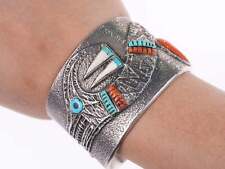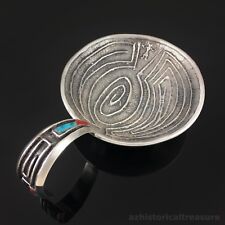Preston Monongye (Hopi) (1927-1987) Tufa Cast Rose Gold Channel inlay bracelet

When you click on links to various merchants on this site and make a purchase, this can result in this site earning a commission. Affiliate programs and affiliations include, but are not limited to, the eBay Partner Network.
Preston Monongye (Hopi) (1927-1987) Tufa Cast Rose Gold Channel inlay bracelet:
$19950.00
Preston Monongye (Hopi) (1927-1987) Tufa Cast Rose Gold Channel inlay bracelet. Fits up to a 6 3/8" wrist, tapers from 20mm to 30mm wide. One of a kind bracelet, extremely rare example in gold. Preston Monongye did not work in a lot of gold, very few pieces have come to market ever, when they do they are crazy expensive. I personally had this machine tested on a $30,000+ XRF machine and it ranges from 40-43% gold (Averaging about 10k) which actually makes perfect sense. Since P Monongye didn't work with a lot of gold, the times he did were likely somewhat experimental. In this case it is somewhat obvious that he melted up some scrap gold, likely some that was brought to him by a customer or friend to make this which was likely a custom piece. The lowest gold content shot we took showed it at 48.13% copper, 40.08% gold, 8.18% silver, 3.49% zinc, and .12% Nickel.Preston Monongye (1927-1987) was an influential proponent of what he called “the new Indian art.” He wrote, “We may use old techniques, along with old designs taken from potsherds or pictographs, but then we redesign them or add innovations of our own.”
Preston had an unconventional and late blossoming path to jewelry making. He served in two wars, worked in law enforcement, and was an employee for the Bureau of Indian Affairs. It was later in life that he decided to dedicate himself full time to jewelry making, which was received numerous awards. He had always experimented with jewelry and craftsmanship, but did not receive acclaim until fully committing to his art. Preston primarily did the metalwork and design for his pieces, letting his friend and acclaimed lapidary artist Lee Yazzie do the inlay, and later allowing his son Jesse Monongye to do his lapidary work. His pieces are exhibited nationwide.Born in East Los Angeles, California, to Mexican and Mission Indian parents, Monongye was adopted by a Hopi family at age seven. He was raised Hopi, speaking the Hopi language and participating in the Katsina Society. At age nine, Monongye began apprenticeship with his uncle, the master silversmith and painter Gene Pooyama.
“He taught me how to live the ‘Hopi way,'” Monongye recalled. Throughout his career, Hopi colors and images were prominent in Monongye’s work.But Monongye was adamant that Native jewelry not be bound by the past, explaining, “An old piece of philosophy given to me by my father and other men of the Hopi Mesas is, ‘If you can progress without hurting your tradition or your , you should do so.”Born in 1927, in Los Angeles he was abandoned at Hopi at age seven and adopted by a prominent Hopi family. Monongye attended reservation schools and became a full participant in Hopi and social life.
Following his service as a paratrooper in World War II, Monongye became a Kachina painter, working occasionally for trader Roman Hubbell and the Fred Harvey Company. Monongye re-enlisted during the Korean War and later worked in law enforcement for the Bureau of Indian Affairs while continuing to paint and make silver jewelry. After leaving his job in favor of jewelry making in the early 1960s, Monongye quickly became recognized as an innovative designer and technician, immersing himself in “the new Indian art,” using traditional techniques and motifs to create a contemporary new look. He was best known for cast silver set with stones that often were cut by his friend Lee Yazzie, and later by his son Jesse. Monongye taught his art at various schools and workshops and lectured widely on contemporary Native design. He won many awards at shows and competitions and his jewelry appears in museum collections such as the Museum of Northern Arizona in Flagstaff and the Wheelwright Museum in Santa Fe.
Preston Monongye (Hopi) (1927-1987) Tufa Cast Rose Gold Channel inlay bracelet:
$19950.00

Related Items:
Preston Monongye (Hopi) (1927-1987) Tufa Cast Rose Gold Channel inlay bracelet
$20947.50
Preston Monongye (Hopi) (1927-1987) Tufa Cast Silver Cuff bracelet
$11851.88
PRESTON MONONGYE - MISSION/HOPI TUFA CAST STERLING SILVER MAN IN THE MAZE DISH
$10000.00







